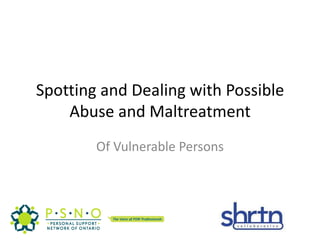
Spotting And Dealing With Abuse
- 1. Spotting and Dealing with Possible Abuse and Maltreatment Of Vulnerable Persons
- 2. Spotting and Dealing with Possible Abuse and Maltreatment of Vulnerable Persons
- 4. gathering sufficient evidence to go further
- 5. consulting with specialists and others knowledgeable of the witness, and most importantly
- 6. avoiding premature action which may result in trauma to the witness or spoil the opportunity for successful detection and prosecution of maltreatment.Spotting and Dealing with Possible Abuse and Maltreatment of Vulnerable Persons
- 8. Report to child welfare officials or
- 9. Report to the police, or
- 10. Gather more information first from other sources under strictest confidentialitySpotting and Dealing with Possible Abuse and Maltreatment of Vulnerable Persons
- 11. The sensitive caregiver must be prepared at the time maltreatment is suspected, to give the matter highest priority, without appearing overly eager, disbelieving, alarmed, judgmental, or personally ill‑affected. Composure can positively affect the likelihood that the individual will tell the story again, in significantly more detail, if the caregiver first "passes" the "trust test". Spotting and Dealing with Possible Abuse and Maltreatment of Vulnerable Persons
- 12. Spotting and Dealing with Possible Abuse and Maltreatment of Vulnerable Persons A successful investigative interview following an allegation can be affected positively by an excellent first response. Similarly, all subsequent evidence, no matter how reliably obtained, may be invalidated, "contaminated" by improper first responses. Improper or insensitive investigations may also traumatize and even "re‑victimize" sensitive and vulnerable victims.
- 14. 2. Reassure the person that s/he has done nothing wrong
- 15. 3. Take your time listening to the person
- 17. 2. Criticize the alleged perpetrator; the person may still care for them or have conflicting feelings about them
- 18. 3. Tell the person you won't tell anyone or that you will keep it a secret
- 19. 4. Ever ask a person why s/he let it happen to themSpotting and Dealing with Possible Abuse and Maltreatment of Vulnerable Persons
- 21. 6. Find out what the person wants to happen
- 22. 7. Deal with unrealistic expectations
- 24. 6. Put words in the person's mouth ‑ let them use their own words and way of communicating
- 25. 7. Make promises you can't keep
- 26. 8. Attempt to assess the truth of the report by yourselfSpotting and Dealing with Possible Abuse and Maltreatment of Vulnerable Persons
- 28. 10. Include another trusted and "safe" person (relative, friend or staff) of the witness
- 30. 10. Forget that if a child is a potential victim, it is YOUR responsibility to ensure Children’s Aid is notifiedSpotting and Dealing with Possible Abuse and Maltreatment of Vulnerable Persons
- 32. Remember - physical injuries may be life threatening without obvious external signs (i.e. head injury, internal organ damage or bleeding).
- 33. Initial disclosure may determine there is potential of obtaining physical evidence (through medical examination).Spotting and Dealing with Possible Abuse and Maltreatment of Vulnerable Persons
- 34. Clear documentation is an essential professional standard: Future prosecution, even on another case Civil action is also possible (suing for damages) Sensitivity to confidentiality (all parties) but very detailed and precise, comprehensive (can be sealed) Spotting and Dealing with Possible Abuse and Maltreatment of Vulnerable Persons
- 35. An allegation, even a potentially false one, needs to be reported and acted upon swiftly by authorities when: a. An alleged perpetrator is named or identified in some manner that suggests the person exists, associated with b. Information which is sufficient to warrant investigation on a criminal charge or child protection concern as set out in the various acts of legislation. Following the "least dangerous assumption" principle (refer to Ethics), when in doubt, a report should be made. Spotting and Dealing with Possible Abuse and Maltreatment of Vulnerable Persons
- 36. Especially, reporters should be aware of "practical deadlines" such as school or program dismissal times, when victims or witnesses may be returning to the high risk situation. Reporters should report faster when allegations come closer to these "practical deadlines", even though the allegations might be vague or unclear and subject to some doubt. Spotting and Dealing with Possible Abuse and Maltreatment of Vulnerable Persons
- 38. Withdrawal, unresponsive, sad, depressed
- 40. Injuries with no adequate matching explanationSpotting and Dealing with Possible Abuse and Maltreatment of Vulnerable Persons
- 42. Extremely poor hygiene, parasites, sores/ulcers
- 43. Persistent non-compliance with medical orders
- 44. Pale, listless, unkempt, thin, undernourished
- 45. Lack of supervision and monitoring
- 46. Unattended needs (glasses, dentures, etc.)Spotting and Dealing with Possible Abuse and Maltreatment of Vulnerable Persons
- 48. Exaggerated fright reactions when approached by caregivers from behind or out of line of vision)
- 49. Fear of the dark, of being alone, of strangers, of new situations
- 50. Other symbolic phobias (i.e. washroom fears)
- 51. Intrusive negative thoughts (i.e. about death, injury, etc.)
- 52. Fear of going to/staying home i.e. from programs
- 53. Fear of certain people or types of people
- 54. Wary of physical contact with adults or caregiversSpotting and Dealing with Possible Abuse and Maltreatment of Vulnerable Persons
- 56. 2. Has there been a marked, gradual or sudden change in the person's behaviour?
- 57. 3. Are a number of behavioural signs present at the same time?
- 58. 4. Is the intensity of these behaviours excessive for the circumstances?
- 59. 5. Are the behaviours transient or enduring?
- 60. 6. Are there developmental or situational crises (within or outside the family) affecting the person which account for the behaviour?
- 61. 7. Are there specific physical problems which may account for the behaviour?Spotting and Dealing with Possible Abuse and Maltreatment of Vulnerable Persons